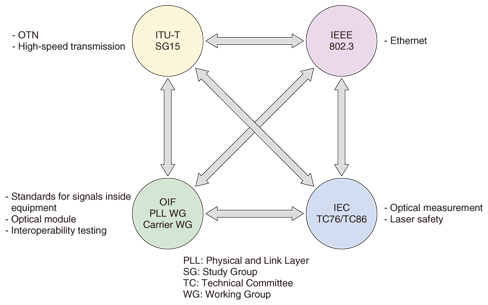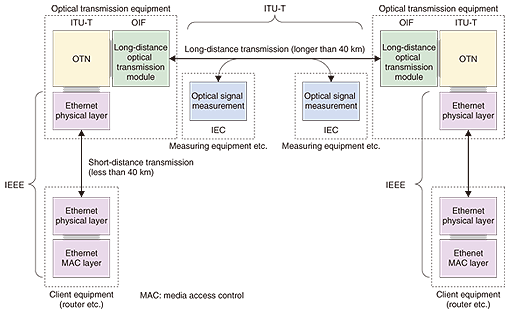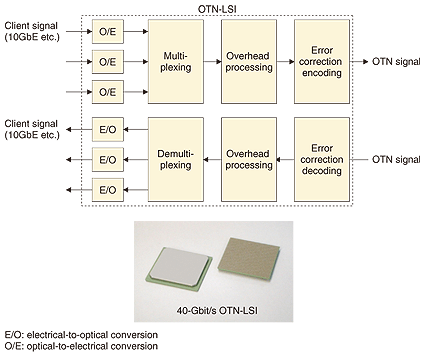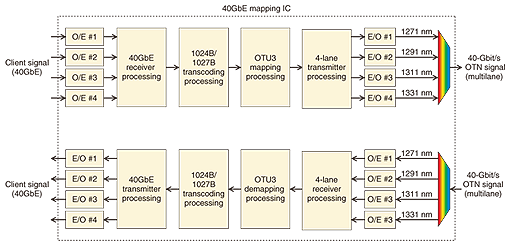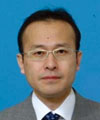 |
|||||||||||||||
|
|
|||||||||||||||
|
Feature Articles: Ultrahigh-speed Ultrahigh-capacity Optical Transport Network Vol. 9, No. 8, pp. 34–39, Aug. 2011. https://doi.org/10.53829/ntr201108fa5 International Standardization and Implementation Technologies for Optical Transport NetworksAbstractThis article introduces recent trends in international standardization related to optical transport networks and NTT°«s standardization activities. We also present standardization activities related to optical transmission with 100 Gbit/s per wavelength, which have drawn attention recently. Furthermore, as an example of applying the standardization results up to now to devices, we introduce two types of large-scale integrated circuits for optical transmission equipment.
1. IntroductionThere has been much progress in various international standards related to transport networks. We can see the benefits of international standardization all around us in our daily lives. There are countless examples such as telephones, faxes, personal computer interfaces, and the TV broadcast system. The significance of such standardization can be recognized through 1) compatibility and interoperability, 2) encouragement of competition and market expansion based on the opening of specifications, 3) reductions in cost due to mass production, and 4) a high level of technology achieved through specialization within an industry. The field of optical communications is no exception. We have gained many benefits through standardization. For NTT, international standardization means that the results produced by its laboratories enable technologies attractive to operating companies to be introduced quickly as international standards. Moreover, it subsequently enables cost reduction and economization to be achieved through mass production, and the global spread and competition of products can be improved through the application of standardized technology by our group companies. There are a number of standardization bodies, forums, and industrial groups in the field of optical communications. The International Telecommunication Union, Telecommunication Standardization Sector (ITU-T), the Institute of Electrical and Electronics Engineers (IEEE), and the International Electrotechnical Commission (IEC) officially establish standards (de jure standards), and industrial groups such as the Optical Internetworking Forum (OIF) decide on practical standards (de facto standards). These standardization bodies have recently compartmentalized the technical areas and are advancing standardization on the basis of a collaborative relationship (Fig. 1). For the extremely high level of technology that is used in optical communication technologies, based on complementary specialization, efficient and fast technological progress can be targeted in the pertinent areas.
2. Standardization activitiesNTT is actively participating in standardization related to optical transport networks. One topic related to optical transport networks that has recently been drawing much attention in international standardization is the increase in transmission capacity achieved by using a speed of 100 Gbit/s per wavelength. Below, we note the 40- and 100-Gbit/s-related activities of each standardization body to date. ITU-T is an international standardization organization subordinate to the UN that focuses on telecommunication standardization. It produces various standards (ITU-T Recommendations). For example, synchronous digital hierarchy (SDH)*1 is a well-known signal multiplexing method that is an international standard for telecommunication systems. Furthermore, wavelength multiplexing technology has been introduced and the Optical Transport Network (OTN) standardized. In recent years, a highly reliable transmission method for new high-capacity client signals such as 40-Gbit/s Ethernet (40GbE) and 100-Gbit/s Ethernet (100GbE) [1] and interface specifications [2] to achieve high-speed optical transmission have been standardized. A series of proposals regarding transport of Ethernet over OTN were submitted by NTT and many of them were accepted. IEEE is a standardization body that is mainly an American scientific society. Familiar examples of its standards are Ethernet (IEEE 802.3) and wireless local area networks (IEEE 802.11). In recent years, it has standardized 40GbE and 100GbE, known as IEEE 802.3ba. In IEEE, NTT has been promoting not only discussion from a telecommunication standard viewpoint, but also support for the telecommunication standard OTN. IEC is an organization that focuses on international standards related to the widespread field of electrical technology. Its purpose is to promote international cooperation and understanding related to standardization and the evaluation of compatibility to those standards in the field of electrical and electronic technologies. To date, as the base, we have fostered knowledge of NTT°«s high-speed transmission technologies and have contributed toward standardization of a 100-Gbit/s modulation format and evaluation techniques. OIF is an industry group that cooperates in the fields of data communications and optical communications [3]. It deals with industry-standard Implementation Agreements (IAs). In recent years, it has advanced discussion of various specifications related to 100-Gbit/s transmission and produced IAs for optical modules (MSA: Multi-Source Agreement)*2, integrated optical transmitters, and integrated optical receivers. On the basis of the technology trends of other standardization bodies, NTT has made proposals that took account of technological feasibility and has contributed to decisions about IAs. As an example of specialization in a technology area among the standardization bodies, we describe high-speed transmission technology. As shown in Fig. 2, optical transmission equipment uses a combination of IEEE-specified Ethernet standards, ITU-T-specified OTN recommendations, and OIF-specified optical module IAs. Since multiple specifications are involved in the configuration of one set of equipment, the standardization bodies that produced them arrange to share information among themselves from time to time to improve the integrity of the specifications. With regard to these standardization bodies, NTT is advancing standardization activities related its own technologies, furthering the understanding of technological trends, and bolstering the framework for cooperative relations among the other organizations involved in standardization.
3. Application of standardization results to actual devicesNext, we describe standardization activities to date and standardization results and give a few specific examples of devices in which the standardized technologies are applied. 3.1 Standardization of 10GbE transport over OTN and OTN-LSIAlong with the increase in the volume of traffic, the enhancement of long-distance transmission is progressing. In particular, the growth in IP (Internet protocol) traffic has been remarkable recently, and the use of Ethernet as an interface has progressed rapidly. However, since the maximum transmission distance in the Ethernet standard is 40 km, it is insufficient for long-distance transmission between large cities. For this reason, ITU-T specifies the OTN as a long-distance transmission medium that achieves high reliability, and such optical transmission equipment is widely used. However, a problem occurs in the transport of 10GbE over the OTN. Since the OTN assumed 10-Gbit/s SDH signals (STM-64) as client signals, this problem arose because the bitrate of 10GbE exceeds the maximum bitrate (payload capacity) of the client signal that can be accommodated in the OTN signal (ODU2). NTT continually advocated the importance of bit-transparent transport of 10GbE, and eventually a new OTN signal (ODU2e) suitable for 10GbE transport was standardized. Concurrently with the ODU2e standardization, NTT developed a large-scale integrated circuit (OTN-LSI) for optical transmission equipment, and NTT Group companies have commercialized it. A photograph of the OTN-LSI and a schematic of its function blocks are shown in Fig. 3. The OTN-LSI accommodates 10GbE in an ODU2e and then multiplexes four ODU2e signals to form a 40-Gbit/s OTN signal OTU3e, which is suitable for long-distance transmission; it is a key device for 40-Gbit/s optical transmission equipment. The OTN-LSI is used by domestic transmission equipment vendors and has been introduced in the NTT operating companies. Furthermore, it has been promoted in the global market, and many system vendors in countries all over the world use it. In this way, we have promoted technological development targeting commercialization concurrently with standardization and have been able to achieve quick deployment of the technologies to our operating companies. Furthermore, through the global promotion of products in our group companies, we are achieving price reductions through mass production and contributing to the economization of system deployment by our operating companies.
3.2 Standardization of 40GbE transport over OTN and mapping ICThe next standardized speeds after 10GbE are 40GbE and 100GbE. Since 100GbE is a new-bitrate client signal for the OTN, ITU-T SG15 (Study Group 15) revised the OTN standard to make it suitable for 100GbE. However, in the same way as in the abovementioned 10GbE case, the bitrate of 40GbE exceeds the maximum bitrate (payload capacity) of the client signal that can be accommodated in the OTN signal (ODU3), which was assumed to be the 40-Gbit/s SDH signal (STM-256). At that point during the discussions on how to accommodate 40GbE in the OTN signal standardization, NTT searched for a way to accommodate 40GbE while maintaining the maximum transparency based on transcoding (rate compression), and our standardization proposals were adopted [1]. Specifically, we proposed replacing the 64B/66B code used for 40GbE by one with less redundancy, 1024B/1027B, and compressing the bitrate, which enable the existing 40-Gbit/s OTN signal (ODU3) to accommodate transcoded 40GbE. Concurrently with this standard, NTT is developing a 40GbE mapping IC (integrated circuit) as an LSI for optical transmission equipment [4]. Its function blocks are shown schematically in Fig. 4. The mapping IC also contains multilane transmission technologies and other features. By using this mapping IC with existing transmission equipment for 40-Gbit/s SDH signals when developing optical transmission equipment for the new 40GbE, we can reduce the development cost. In this way, NTT laboratories are effectively using previous development assets in equipment development that supports newly standardized technologies, considering ways to minimize the total development cost toward system deployment, and advancing device development.
4. SummaryNTT is advancing various international standardization activities related to optical transport networks in order to improve the business competitiveness of NTT Group companies by providing customers with attractive services and promoting NTT technologies in the global market. We are continuously promoting international standardization of technologies created in NTT laboratories and are progressing toward device applications. References
|
|||||||||||||||








